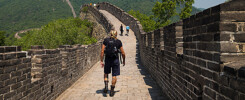Altai, Mongolia, 2016. We have been camping in our tent the past few days. On this month-long visit to Genghis Khan’s home country, our accommodations have ranged from hotel rooms and hostels to lodges and tents.
We are walking out of a valley and looking at our map to decide our next destination. Suddenly, we see a minibus similar to the Russian marshrutka from World War II approaching down the road. It’s loaded with stuff and amidst all of it a man and a woman are squeezed in.
Since it’s all in Mongolian and our command of the language is pretty non-existent, we just point on our map. We put our bags on the roof of the 4WD Russian minivan. We go some kilometers, stop, and the man and woman get out, look at the ground or the river, then get back inside the van; a few more kilometers forward and again we stop at another spot, then do the same procedure. I say to Tanya, “I think they are looking for a new place to live.”
The third spot that we find is on high ground close to the river. This happens to be the right one. We put in 5 hours setting up a Mongolian ger. (Moving from one place to the next takes a whole day.) After helping them out between beers, eating a rice bowl and drinking fermented yak milk, we are off in the early evening.
We cover only around 5 kilometers this day, but we leave with a much richer experience. Time is not so important here; you live and take your time.
The Nomadic Lifestyle
Mongol nomads move 3-4 times a year for food for their animals. The land is open to set up your ger, in whichever location you find is good for fodder and drinking water. It has been this way for thousands of years, from the time of Genghis Khan. The only difference is that nowadays there’s a parabolic antenna and a truck and/or motorbike outside of their ger. Otherwise, not much has changed.
The sky is high, the land open and vast. I get the same feeling when I pass through the Sahara or when I’m in the Swedish tundra. Here there’s space to move, to contemplate, to breathe!
Maybe it’s the nomadic spirit that needs the space. Mongols practice Buddhism, yet they are very much like the steppe Indians of North America and the Sámi people of Scandinavia.
Their roots come from the spirit of nature. They are a proud yet soft-spoken people, beautiful in their way. We have yet to speak the language, but we get around.
* A Mongolian ger is similar to a yurt, except that a ger is round in shape, while a yurt is triangular (and closer in appearance to the tipi used by the indigenous peoples of the Americas). Both types are used by nomads in Mongolia. According to how it was explained to us and what we have seen, yurts are used more by the reindeer people in the northern part of Mongolia.



